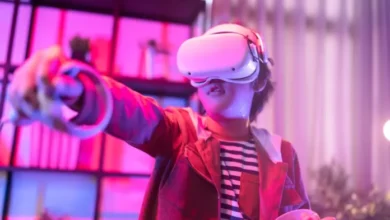
How Real is the Virtual Universe Metaverse
In January 2022, Microsoft announced its groundbreaking intention to purchase the gaming behemoth, Activision Blizzard, in a transaction valued at $69 billion. For numerous observers within the industry, Microsoft’s decision, the architect behind the Xbox gaming console, appears deeply influenced by the burgeoning metaverse trend.
The prefix ‘meta’ traditionally refers to physical goods and services but, within the metaverse context, it signifies a digitalized reality. This fusion creates a vast digital universe.
The era following the year 2000 has seen a swift acceleration in digital advancements. The Metaverse, with its unique society and economy while avoiding centralization, is progressively integrating into our lives, albeit still in its early stages. The metaverse is not a monolithic entity; it comprises various platforms launching groundbreaking projects, broadening the scope of possibilities for their users.
Imagine a vast digital universe, yet one that is multi-dimensional.
Our daily existence is gradually shifting towards a digital framework. More precisely, the metaverse presents a blend of digital and physical worlds, emerging as a decentralized virtual cosmos.
It may be easier to envision the Metaverse as a network of interconnected nodes, each adding to a complex structure. This framework spans economy, society, arts, and sports, forming an extensive domain where every conceivable physical aspect has a digital counterpart.
Blockchain and Digital Gaming: An Unbreakable Link

Blockchain technology, introduced in 2008, plays a crucial role in the vast universe of the metaverse by recording data across interconnected blocks. This method of linking data has significantly streamlined a wide range of economic transactions across networks, enhancing efficiency and increasing the volume of transactions processed. It’s a widely held belief that the metaverse would not be feasible without blockchain technology.
It’s also essential to recognize the digital gaming industry’s influence in developing metaverse platforms, as a result of multifunctional integrations, as equally critical to blockchain’s role. This perspective provides insight into Microsoft’s substantial $69 billion offer for a gaming company.
Following Microsoft’s announcement of its acquisition plans in January 2022, the UK’s Competition and Markets Authority (CMA) launched an investigation in September 2022. By April 2023, the CMA blocked the acquisition, citing concerns about its potential impact on the future of the cloud gaming industry.
The U.S. Federal Trade Commission (FTC) also reviewed the deal, with concerns differing from those of the UK’s regulatory authority. The FTC was worried about the possibility of Microsoft compromising the quality of Activision’s games or the gaming experience on competing consoles, such as Nintendo and Sony’s PlayStation, as well as potential manipulative pricing strategies or changes to the terms of access to Activision’s content.
However, on July 12, a San Francisco court ruled in favor of Microsoft’s acquisition. Despite this, the FTC remained adamant, appealing the decision to a higher court on July 15.
Microsoft President Brad Smith commented, “We are dedicated to collaboratively addressing legal concerns, a commitment we have maintained throughout this process.”
The gaming sector has been at the forefront of the digital revolution, yet initially, there was a noticeable lack of unity among gaming platforms. As these platforms evolved, major players in the industry emerged, and virtual games became nearly indistinguishable from real-life experiences. Recognizing this opportunity, tech giants increased their investments. Microsoft’s bold $69 billion acquisition is a clear indication of this trend.
NFTs are the other link in the chain.

A Non-Fungible Token (NFT) represents a digital asset that is unique, rendering it non-interchangeable. Essentially, it is a specific piece of data stored on a digital ledger within a blockchain framework.
Exploring further, in Turkish, NFT translates to a concept similar to “Qualified Intellectual Property.” For instance, creating an avatar in the digital world doesn’t automatically secure your place in the Metaverse. Primarily, the originality and uniqueness of your creation must be validated.
If digital assets, analogous to physical items such as artwork, music, video games, or videos, can be authenticated as unique, they qualify as NFTs. These assets often enter online marketplaces, where they are typically traded for cryptocurrency.
The Metaverse offers an infinite digital universe where virtually any conceptual value can be acquired. Picture buying a piece of lunar land. In this scenario, you would be acquiring the lunar plot as a symbolic digital asset. Upon completing this transaction, you gain the freedom to utilize this asset as you see fit.
Specific platforms have been developed to facilitate NFT trading. Prominent marketplaces like OpenSea, Rarible, SuperRare, Axie Infinity Marketplace, and Mintable see transactions reaching millions of dollars. It’s important to note that a portion of each sale usually goes to the NFT’s original creator as a royalty.
Transactions on these platforms are often conducted using the platform’s specific cryptocurrency. For example, to engage in transactions on OpenSea, one of the leading NFT marketplaces, you would initially need to have Ethereum cryptocurrency.
Metaverse investments and Fintech

In the vast expanse of the metaverse, investments from technology companies and banks are on the rise. The metaverse has enabled individuals to virtually visit any global bank from the comfort of their homes and effortlessly conduct their financial transactions. Leading banking institutions are advancing by transferring digital versions of their physical assets, operations, and systems into the metaverse.
This concept is known as “Digital Twins.” More specifically, it is referred to as FinTech. FinTech companies are integrating their innovations with artificial intelligence, data analytics, and blockchain to improve the traditional financial sectors, enhancing their security, speed, and efficiency.
FinTech, a blend of “finance” and “technology,” has become an integral part of our daily lives. This term covers cutting-edge technologies aimed at transforming, digitalizing, and automating traditional financial services processes.
Fintech in Metaverse banking

Banks and financial institutions are transitioning into the Metaverse, enabling communication with customers in virtual reality. Major banks are migrating their traditional banking transactions to the virtual universe of the Metaverse. In this endeavor, they collaborate with FinTech companies to digitize their assets.
The approach of banks entering the Metaverse universe to serve their customers allows consumers to conduct virtual payments and virtually experience the features of a branch.
Artificial intelligence in banking

Banks and financial institutions are aiming to overcome the physical limitations of traditional banking services. In their pursuit, they are leveraging virtual reality and artificial intelligence through Fintech and the Metaverse to make services more engaging and immersive.
Financial organizations, in partnership with Fintech companies, are using the Metaverse’s virtual reality capabilities, powered by AI, to transform and add interactivity to financial interactions. They are eager to develop new products specifically designed for the Metaverse to maintain a competitive edge.
Traditionally, banks and financial entities have relied on what is known as “TradFi,” or traditional finance systems. JP Morgan Chase, a leading bank in the U.S., is no exception. However, seizing the opportunities presented by the Metaverse, JP Morgan entered the Metaverse in 2022 by opening an office in Decentraland, a virtual world powered by blockchain technology. This move marked the first time a bank established a presence on a Metaverse platform.
Not to be left behind, Bank of America introduced a VR-based training program that simulates real-life customer interactions for its extensive workforce of 50,000.
Major corporations, including Samsung, Nike, and Burger King, have also ventured into the Metaverse by launching their virtual storefronts.
How safe is Metaverse?

Securing the vast amount of data within such an expansive virtual universe as the Metaverse might appear to be a formidable challenge. Companies, organizations, or governmental bodies typically house their data on servers within their private networks. This setup could involve a single server or, possibly unbeknownst to many, multiple servers where millions of data points are stored.
However, the databases for the Metaverse, NFTs, and blockchains are not limited to just one or a few servers. Rather, they are spread across millions of servers within the network. This means that to compromise a single piece of data, a hacker would need to breach millions of computers on that network simultaneously. It’s important to recognize, however, that this does not make the Metaverse immune to hacking attempts. In fact, there have been several efforts to penetrate Metaverse platforms, NFTs, and blockchain systems. Herein lies the critical importance of cybersecurity measures.
Many cybersecurity firms are now entering into partnerships with Metaverse platforms, emphasizing the need for rigorous security. As a result, experts often advise those interested in purchasing Metaverse assets to thoroughly examine the security protocols of these platforms beforehand. In the end, experts argue that an NFT bought from Metaverse virtual platforms could potentially offer more security than the funds in a traditional bank account.
Games, entertainment and shopping are popular on Metaverse

The global community is still in the early stages of understanding artificial intelligence, and the Metaverse is racing to integrate with AI’s rapid advancements. An increasing number of businesses and institutions are venturing into the Metaverse, staking their claim in this digital realm.
A recent research report from the management consulting giant, McKinsey & Company, titled “Creating Value in the Metaverse,” offers insights into what the Metaverse’s future might hold. This comprehensive study involved over 3,400 global consumers and 450 top-tier business executives. One intriguing finding is that 59% of respondents expressed a preference for conducting at least one activity virtually rather than in person. Their motivations centered on connecting with influential individuals and diving into virtual explorations. The top virtual activities that resonated with the survey participants reflect the Metaverse’s current reality: shopping, attending virtual events, gaming, fitness, virtual dating, and e-learning. These areas, it seems, are the Metaverse’s most sought-after domains at this nascent stage.
The report highlighted that the Metaverse saw investments amounting to $57 billion in 2021. Fast forward to 2022, and over $120 billion has already been channeled into the Metaverse. This figure is projected to skyrocket to an astounding $5 trillion by 2030.
Adding to this narrative, on July 15, the German tech giant Siemens announced an investment of 1.12 billion Euros towards new infrastructural developments, with a special emphasis on the Metaverse. Siemens’ CEO, Roland Busch, commented, “We’re revolutionizing two-thirds of our product line, dedicating a significant portion of our investments to cutting-edge research and development. We plan to boost our production capacity by 60% at the same venue. This expansion will unfold without halting ongoing production. And how will this be achieved? Through a Metaverse-assisted simulation.”
Contemplating the convergence of the Metaverse with AI-driven applications evokes wonder. It’s genuinely challenging to fathom its full potential because the Metaverse promises to transcend our wildest imaginations.
You may also like this content
- Is the Metaverse Over?
- Best 8 VR Headsets for the Metaverse in 2025, Features & Prices
- What Would Your Profession Be in the Metaverse?
Follow us on TWITTER (X) and be instantly informed about the latest developments…











